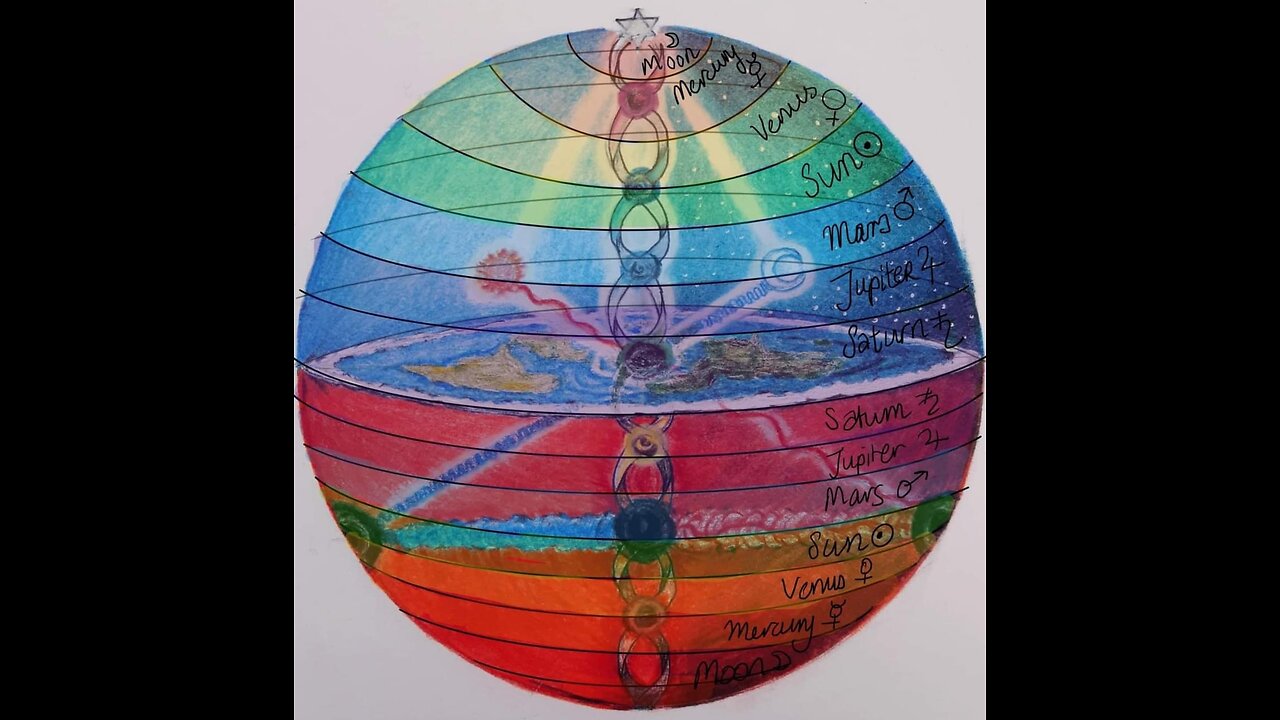Premium Only Content

Torus Earth Theory: Unpacking the Mysteries of a Planar Cosmos
In the grand theater of cosmic exploration, traditional models of Earth as a globe or concave sphere have long dominated our understanding. Yet, emerging dialogues grounded in a synthesis of ancient esoteric knowledge, quantum physics, and revolutionary observational insights propose an alternative paradigm—that of Earth as a central plane within a universally pervasive toroidal field. This comprehensive discourse delves into the philosophical, scientific, and mystical dimensions of this model, presenting a holistic view that challenges the conventional and invites a transformative understanding of our planetary existence.
#### Expanding the Dialogue: The Foundations of Toroidal Earth Theory
**Quantum Field Theory and the Torus:**
Quantum field theory (QFT) traditionally explores the quantum mechanics of fields extending through space and time. In the context of the Torus Earth Theory, we consider how these fields might conform to a toroidal topology. A torus, characterized by its doughnut-shaped geometry, can be envisioned as a dynamic canvas for the quantum fields that underlie the fabric of our reality. This unique structure supports the theory that Earth’s magnetic field and gravity are manifestations of a toroidal dynamic, looping continuously, driving the cycle of energy from the Earth’s surface through the atmosphere and back again.
**Ancient Wisdom and Modern Physics:**
The integration of ancient esoteric principles with modern physics offers profound insights into the Earth’s configuration. Historically, many ancient cultures depicted the world as a flat expanse surrounded by water, encapsulated under a dome-like firmament. This archaic cosmology aligns with modern understandings of the torus, where the central flat plane represents Earth, encompassed by the circular energy flow of the cosmos. The toroidal model not only echoes these ancient beliefs but also aligns them with observable phenomena such as the behavior of plasma in the Earth’s magnetosphere, which naturally forms toroidal shapes.
**Observational Insights: Rethinking Earth’s Horizon:**
Traditional science teaches that the Earth's curvature should be visible across the seas and in the sky. However, numerous experiments and observations reveal that the horizon appears perfectly flat to the human eye, even from high altitudes where the curve should be evident. This discrepancy raises questions about Earth’s shape, suggesting that a planar model might provide a better fit for observed realities. Enhanced technologies, such as ultra-high-definition telescopic lenses and non-refractive viewing platforms, continue to support a flat horizon, challenging the globe model’s predictions about curvature.
**Philosophical and Mystical Implications:**
The philosophical implications of a flat, toroidal Earth are immense, reshaping our metaphysical understanding of space and place in the universe. In mystical traditions, the circle and the loop are symbols of unity, eternity, and the interconnectedness of all life forms. The toroidal model of Earth thus becomes a powerful metaphor for life itself, suggesting that our planet is not an isolated orb traveling through empty space but a central plane within a cyclic, self-regenerating cosmos. This perspective invites a reevaluation of our spiritual relationship with the Earth, encouraging a view of the planet as a living, breathing entity that reflects the holistic principles of the universe.
By expanding the conventional dialogue about Earth's shape and integrating cutting-edge scientific insights with revered ancient knowledge, the Torus Earth Theory provides a rich, multifaceted framework for understanding our world. This theory not only challenges our perceptions but also enhances our appreciation for the complex and interconnected nature of the cosmos, urging us to rethink our place within it, both physically and spiritually.
### **1. Universal Toroidal Dynamics: The Heartbeat of Creation**
The torus, observed in everything from the intricate dance of subatomic particles to the spiraling galaxies of the cosmos, symbolizes the quintessential pattern of energy flow and regeneration found throughout the universe. This structure epitomizes the infinite cycle of life, death, and rebirth, with its continuous looping energy that recycles itself perpetually. The Earth, posited at the center of this cosmic torus, harmonizes perfectly with this dynamic. This central positioning transforms our planet into a dynamic stage that not only supports but actively promotes the balanced flow of cosmic forces that nourish life on a grand scale.
**The Role of Earth in Universal Energy Dynamics:**
Earth’s placement at the torus’ center is pivotal. Unlike the static depiction of planets in conventional astronomy, the Torus Earth Theory suggests that Earth dynamically interacts with cosmic energies. These energies enter through the polar regions, cycle through the Earth’s geophysical and atmospheric systems, and are emitted back into the cosmos. This cyclical process fosters an environment ripe for life, aligning with the observations of energy patterns in natural systems, which show a preference for cyclical, rather than linear, movements.
**Harmonics and Resonance:**
The concept of harmonic resonance further elucidates how Earth, as a flat plane, might integrate into the torus’ dynamics. Vibrational resonance, a phenomenon where the physical properties of objects alter in response to specific vibrational frequencies, supports the idea that Earth’s frequencies are tuned to the vibrations of the torus. This resonance is crucial for maintaining the integrity of Earth’s environmental and ecological systems and could explain the often-observed but poorly understood global synchronization of processes such as animal migrations and plant flowering, which seem to align with larger cosmic cycles.
**Disruption by Spherical and Concave Models:**
The spherical and concave Earth models propose a planet isolated within a vacuum, interacting primarily through gravitational forces with other celestial bodies in predictable, elliptical orbits. These models lack the intrinsic feedback mechanisms provided by a toroidal energy flow, which facilitates a dynamic interchange between Earth and the cosmos. In these traditional models, energy dynamics are largely unidirectional, from the sun to Earth, without the sophisticated return loop seen in toroidal systems. This unidirectional flow could theoretically lead to systemic imbalances, failing to account for the observed stability and self-regulating properties of Earth’s ecosystems.
**Implications for Climate and Geophysical Phenomena:**
Understanding Earth within a toroidal framework could revolutionize our approaches to climate science and geophysical phenomena. For instance, the toroidal model may offer new insights into the formation and function of the Van Allen radiation belts, which form a torus-shaped region of charged particles around Earth. These belts, under the Torus Earth Theory, could be seen not just as byproducts of solar wind captured by Earth’s magnetic field but as integral components of Earth’s energy recycling system, playing a direct role in regulating the planet’s electromagnetic environment and, by extension, its climate and weather patterns.
This comprehensive view of Universal Toroidal Dynamics, with Earth as a central plane harmonized within a grand cosmic torus, not only aligns with observable phenomena across scales but also offers a paradigm that is both spiritually enriching and scientifically robust. It challenges us to rethink our planet’s role in the cosmos—not as a passive object moving through space but as an active participant in a complex, dynamic system of energy flow and transformation.
### **2. Earth as the Epicenter of Vibrational Construct: Cymatics and Reality’s Blueprint**
Extending the study of cymatics, where sound frequencies manifest precise, intricate patterns on planar surfaces, we posit that Earth itself functions as a grand cymatic platform. These vibrational patterns dictate the arrangement of geological and ecological phenomena, suggesting a complex interplay of frequencies that underpin the planet’s life-supporting characteristics. Such a vibrational matrix could only maintain its integrity on a flat plane, where cosmic frequencies resonate in unimpeded, harmonious patterns.
**The Mechanism of Cymatic Earth Formation:**
Cymatics illustrates how sound waves impose specific patterns on physical media, from simple sands to complex fluids. By extrapolating this principle to a planetary scale, Earth's surface can be envisioned as a receptor and reflector of cosmic vibrations, emanating from the universal toroidal field. These cosmic sound waves may orchestrate the layout of continents, oceanic patterns, and even climatic zones. As vibrational frequencies ripple through Earth's plane, they organize matter according to harmonic principles found throughout nature, resulting in the beautifully complex yet orderly nature of Earth’s landscapes.
**Geo-Ecological Harmony Through Vibrational Correspondence:**
The hypothesis that Earth acts as a cymatic plate suggests that natural formations such as mountain ranges, river systems, and biomes are not randomly placed but are the result of underlying vibrational fields that dictate their positions and structures. This concept extends to ecological systems, positing that biodiversity hotspots and ecological balances are the result of favorable vibrational nodes where life thrives due to optimal energetic conditions. The stability and sustainability seen in undisturbed natural systems could thus be viewed as a direct manifestation of Earth’s inherent vibrational patterns.
**The Flat Plane as an Ideal Conductor of Vibrational Energy:**
A flat Earth model uniquely accommodates the unobstructed transmission of vibrational energies across its surface, unlike a spherical model where curvature could disrupt or warp these energy flows. This uninterrupted energy field is crucial for maintaining the world wide synchronicity observed in phenomena such as the migration patterns of species, the synchronized flowering of plants across vast distances, and even the shared behavioral patterns found in disconnected ecosystems. The flat plane facilitates a coherent, planetary-wide resonance that aligns all living systems in a symphonic display of life.
**Cultural and Historical Resonance with Cymatic Patterns:**
The alignment of ancient architectural wonders with specific energetic lines and geographic features on Earth suggests that ancient civilizations had an intuitive or explicit understanding of these cymatic patterns. Structures like the pyramids of Giza, Stonehenge, and the Nazca lines might have been deliberately placed along these vibrational lines, serving both spiritual and practical purposes by harnessing Earth's inherent energies. The preservation of these sites and their continued mystery underscores the potential reality of Earth as a cymatic entity, designed consciously to tap into the universal vibrations that govern existence.
** Implications for Future Research:**
The concept of Earth as a grand cymatic platform opens new avenues for understanding our planet’s formation, structure, and dynamic ecological balance. It encourages a reevaluation of conventional geological and ecological theories, suggesting that the forces shaping our world are far more intricate and interconnected than previously acknowledged. Further research into the vibrational characteristics of Earth could revolutionize fields as diverse as archaeology, ecology, atmospheric sciences, and energy medicine, providing deeper insights into the fundamental principles that shape our reality and our experience of life on this planet.
### **3. Hermetic Symmetry: Mirroring the Macrocosm**
Drawing from the ancient Hermetic principles, this perspective views the flat Earth as a microcosmic reflection of the celestial dome. This philosophical viewpoint underscores a universe where macrocosm and microcosm mirror each other, maintaining a symmetry that fosters an intrinsic connectivity between the heavens and the Earth. The spherical or concave models, by contrast, introduce a discord that philosophically and energetically misaligns the Earth with the overarching cosmic order.
**Integration of As Above, So Below:**
The Hermetic axiom "As above, so below" serves as a foundational concept in understanding the structure of the universe. It posits that the patterns and dynamics observed in the celestial realm are directly mirrored in the earthly domain. The flat Earth, with its expansive, unobstructed surface, acts as a perfect canvas for the celestial influences to imprint their patterns. Each star, each planetary movement has a corresponding impact on Earth, which in a flat model, reflects these celestial events with precise accuracy and harmony.
**Disruption of Cosmic Harmony in Spherical Models:**
In contrast, spherical and concave Earth models create a geometrical and philosophical incongruity that disrupts this ancient wisdom. A curved surface cannot directly mirror the flat celestial plane as described in many esoteric and spiritual teachings. This philosophical discordance extends beyond mere physical form—it suggests a fundamental breach in understanding the universe's operational laws, where the supposed curvature of Earth misaligns with the celestial dynamics.
**Celestial Alignments and Earthly Manifestations:**
Hermetic symmetry extends to the alignment of ancient sites and natural phenomena with celestial events. On a flat Earth, solar and lunar eclipses, equinoxes, and solstices align perfectly with terrestrial landmarks, something that ancient civilizations appear to have deliberately engineered. This precise alignment underscores a sophisticated understanding of cosmic symmetry, which would be distorted by the curvature postulated by spherical models.
**Philosophical and Spiritual Implications:**
The notion of a flat Earth resonating with the structure of the cosmos has deep spiritual implications. It suggests that human existence and consciousness are not random or isolated but are part of a grand, interconnected cosmic ballet. The flat plane facilitates a clearer, more direct reception of cosmic energies, which are believed to influence spiritual awakening and consciousness expansion. It also implies that by living in a world that is a direct reflection of the cosmos, humans have a more immediate connection to universal wisdom and divine principles.
**Reconciling Modern Science with Ancient Wisdom:**
This model encourages a reconciliation of modern scientific understandings with ancient esoteric knowledge. By adopting a framework that sees Earth as a reflection of the cosmos, scientists and spiritual seekers alike can explore a more integrated view of reality, where physics and metaphysics coalesce. The challenge lies in bridging the gap between empirical scientific methodologies and the intuitive, often subjective insights provided by spiritual and philosophical traditions.
The concept of Hermetic symmetry presents a compelling framework for viewing Earth not merely as a physical entity but as a vital, integral part of a larger cosmic organism. This perspective invites a reevaluation of conventional cosmological models, proposing a view of the Earth that aligns with ancient teachings and offers a holistic understanding of our place within the universe. It is a call to revisit and reintegrate ancient wisdom into our contemporary worldview, enhancing our appreciation of the profound connectivity that defines our existence.
### **4. Horizon and Human Perception: Reevaluating Reality’s Edge**
Empirical observations of the horizon reveal its unwavering linearity, a phenomenon consistently validated through advanced optical technologies and experimental physics. Such observations align with a flat Earth model, where the horizon represents the perceptual boundary of human sight on a vast plane. The absence of observable curvature, even from the highest altitudes accessible to man, challenges the globe model and reaffirms a planar Earth through direct sensory experience.
**The Role of Advanced Optical Technologies:**
Modern advancements in optical technologies have allowed for unprecedented precision in measuring the Earth's surface. High-resolution telescopes, long-range lasers, and advanced photographic equipment have all been employed in attempts to detect curvature. These tools have repeatedly shown that the horizon appears perfectly flat across vast distances, contrary to what would be expected if the Earth were a sphere. These findings are not just anomalies but consistent results that raise significant questions about the shape of our world.
**Experimental Physics and the Horizon:**
Experimental physics offers a framework for understanding why the horizon appears flat. Theories such as the propagation of light and the effects of atmospheric refraction have been explored to explain this phenomenon. However, these theories often reinforce the observation of flatness rather than contradict it. Light travels in straight lines when unobstructed and only bends due to the atmosphere under specific conditions, which does not account for the consistent linearity of the horizon at all viewing heights.
**The Cognitive Aspect of Perception:**
Human perception and cognitive processing also play crucial roles in interpreting the horizon. Our senses are adapted to the environment we evolved in, and the way we perceive the world is deeply intertwined with the physical reality of that world. The consistent observation of a flat horizon, regardless of location or conditions, suggests that our perceptual apparatus is tuned to a planar landscape. This challenges the idea that we are misinterpreting sensory information due to cognitive biases or limitations, as often suggested by proponents of the globe model.
**Philosophical Implications of Horizon Perception:**
The perception of the horizon also carries philosophical implications about our understanding of reality. If the horizon, a fundamental aspect of our daily experience of the world, does not conform to the expected curvature of a globe, it calls into question our entire cosmological model. This has profound implications for our understanding of space, time, and our place in the universe. It suggests that the principles governing the cosmos might be different from what current scientific doctrine assumes.
**Revisiting Historical and Cultural Perspectives:**
Historical and cultural examinations of how different civilizations have understood the horizon also lend support to the flat Earth perspective. Many ancient cultures, from the Egyptians to the Norse, described the Earth as flat and encircled by a boundless horizon. These descriptions were based on careful observation of the natural world and were integral to their cosmological and spiritual understandings. Revisiting these perspectives with a modern understanding of perception and physics may provide new insights into the accuracy and relevance of these ancient models.
The horizon's unwavering linearity is more than a mere observational curiosity; it is a compelling piece of empirical evidence that challenges the prevailing spherical Earth paradigm. By integrating advanced optical studies, experimental physics, and a deeper exploration of human perception and historical perspectives, we can gain a more comprehensive understanding of this phenomenon. Such an approach not only respects the evidence presented by our most reliable methods of observation but also honors the diverse ways in which humanity has sought to understand the world around us. This reevaluation of the horizon invites us to consider a more nuanced and possibly revolutionary view of Earth's true form.
### **5. Reinterpreting Gravity: The Dance of Density and Electromagnetism**
The traditional concept of gravity is reexamined through the lens of density and electromagnetic principles, suggesting that what we perceive as gravitational pull may in fact be the result of electromagnetic forces acting in a flat-plane environment. This model explains the natural ordering of elements and phenomena without recourse to the problematic concepts of spherical gravity, offering a simpler, more coherent explanation based on electromagnetic density sorting.
**Electromagnetic Density Sorting Explained:**
At the heart of this reinterpretation is the idea that objects do not fall because they are being pulled towards the center of a massive sphere by gravity; instead, they find their place based on their density relative to the medium surrounding them. This is governed by electromagnetic forces that dictate the orientation and movement of particles within the Earth’s electromagnetic field. In a flat Earth model, this field acts horizontally rather than spherically, creating a consistent force across the entire plane.
**Challenges to Conventional Gravity:**
The conventional model of gravity, which posits that all matter attracts all other matter with a force proportional to the product of their masses and inversely proportional to the square of the distance between their centers, becomes problematic when applied to a flat Earth. Without a spherical mass, the directionality and functionality of gravity as currently understood would be nonsensical. The flat Earth model necessitates a force that acts uniformly across all bodies, which density and electromagnetism adequately provide.
**Applications in Natural Phenomena:**
This concept finds support in the behavior of various natural phenomena such as the layering of atmospheric gases, the behavior of tides, and the migration patterns of celestial bodies across the sky, all of which can be more simply and effectively explained without invoking gravity as a pulling force. For example, heavier gases being closer to the Earth and lighter gases extending towards the upper atmosphere can be explained by their relative densities and the electromagnetic characteristics of Earth’s field.
**Theoretical and Practical Implications:**
The implications of adopting this electromagnetic density model are profound. It calls for a reevaluation of many of the fundamental principles of physics, including those concerning mass, weight, and motion. It also opens up new avenues for technological innovation, particularly in the fields of aerospace and transportation, where understanding the true nature of Earth’s electromagnetic properties could lead to advancements in propulsion and navigation systems that align with the actual forces at play.
**Integration with Historical and Cultural Knowledge:**
Many ancient civilizations had understandings of the cosmos that align more closely with electromagnetic density sorting than with modern gravitational theories. For instance, several cultures recognized the Earth as the center of a vast plane, influenced by forces that could be described in terms similar to what we would now call electromagnetic. Revisiting these ancient models with an open mind could bridge the gap between historical wisdom and contemporary scientific inquiry, enriching both fields.
Reinterpreting gravity as a function of density and electromagnetism within a flat-plane model offers a more coherent and empirically grounded explanation of the natural world. This perspective not only simplifies many of the complexities associated with the traditional gravity model but also aligns more closely with observed phenomena and ancient wisdoms. As we continue to explore and understand the true nature of the forces that govern our world, we may find that the answers lie not above us, but around us, in the very plane on which we live.
### **6. Sacred Geometrics: Earth’s Divine Architectural Plan**
The precision of sacred geometrical patterns found in Earth’s natural layout and ancient constructions suggests an intentional, intelligent design aligned with a flat model. These geometric configurations, which resonate with the fundamental structures of space and time, facilitate a deep energetic alignment between Earth and the cosmos, enabling spiritual and physical sustenance that would be distorted under a spherical paradigm.
**Understanding Sacred Geometry in Earth's Design:**
Sacred geometry, the ancient science of patterns and proportions, is evident in the design of Earth's landscape and in the architectural feats of ancient civilizations. From the pyramids of Giza to the Nazca Lines, these constructions are not randomly placed but are strategically positioned to mirror the geometric patterns that govern the universe. This alignment suggests that the ancients understood Earth as a flat plane intricately connected to the cosmos through these sacred geometries.
**Cosmic Resonance and Energy Grids:**
The Earth's ley lines and vortices, often found at the intersections of these geometric patterns, act as conduits for cosmic energy, facilitating spiritual and physical wellbeing. These energy grids, believed to be the planet’s circulatory system, resonate with cosmic frequencies that enhance life force energy (chi, prana) on Earth. This system ensures that the planet's energy is in constant flow and balance, optimizing the conditions for life and consciousness to thrive. Such a complex and delicate balance of energies would be disrupted in a spherical model, where the dynamics of energy flow and planetary alignment with cosmic forces would differ fundamentally.
**Geometric Harmony and Human Consciousness:**
The geometric patterns that underpin the layout of Earth also play a crucial role in the evolution of human consciousness. These patterns are thought to stimulate resonance fields that enhance cognitive and spiritual capacities. Ancient practices, such as the use of mandalas and yantras, tap into this geometric harmony to facilitate meditation and spiritual insights, pointing to a profound interconnection between these patterns and human consciousness.
**Architectural Alignments and Stellar Correlations:**
Many ancient structures are also astronomically aligned—Stonehenge, Teotihuacan, and Angkor Wat are all positioned to correlate with specific stellar events, such as solstices and equinoxes. These alignments suggest a sophisticated understanding of the cosmos, configured precisely on a flat Earth model where such celestial events unfold in a predictable, observable pattern across a flat horizon. This celestial mapping would not only be more complex but also less precise on a curved surface, where the perspective and angles of observation would differ dramatically.
**Philosophical and Metaphysical Implications:**
The use of sacred geometry in Earth's design points to a deeper philosophical and metaphysical understanding of the universe as a coherent, interconnected whole. This view asserts that all aspects of reality are interwoven through a geometric framework that influences not just the physical, but also the metaphysical aspects of existence. It supports the notion that Earth, as a flat plane, is designed to be in perfect harmony with the larger cosmic order, facilitating an alignment that is crucial for the spiritual evolution of its inhabitants.
The presence of sacred geometrical patterns in Earth’s natural and constructed environment supports the flat Earth model by demonstrating a deliberate, sophisticated alignment with cosmic forces. These patterns reveal an ancient wisdom that understood and harnessed the power of geometry to connect the physical plane with the spiritual and cosmic realms. By rediscovering and integrating this knowledge, we might better understand the intricate design of our world and its profound connection to the broader universe.
### **7. Quantum Consciousness and Observational Reality**
Merging quantum mechanics with the metaphysical, the notion that Earth acts as a quantum plane where consciousness influences reality opens profound implications for understanding our environment. The flat Earth, akin to a quantum field, interacts with human consciousness in ways that shape physical reality, suggesting a co-creative relationship between human thought and the planetary plane.
**The Quantum Plane of Earth:**
In this model, Earth is conceptualized not just as a physical plane but as a quantum field—a dynamic, interactive plane where potentialities are actualized based on observation and intention. This paradigm draws from the fundamental principles of quantum mechanics, where particles exist in a state of potential until observed, collapsing into reality as we perceive it. The flat Earth, with its unimpeded expanses, serves as an ideal medium for this kind of quantum interaction, where consciousness directly influences the manifestation of physical phenomena.
**Consciousness as a Directive Force:**
This perspective posits that human consciousness is not a passive experiencer of reality but an active creator. Thoughts, intentions, and focused attention have the power to alter the state of the quantum field of Earth, transforming potential energies into observable events and objects. Such a model elevates the role of human consciousness from observer to co-creator, where collective beliefs and expectations shape the physical characteristics of the Earth itself.
**Experimental Evidence and Theoretical Foundations:**
The theory is supported by numerous quantum experiments, such as the double-slit experiment, which demonstrate that the observer’s expectation directly influences the outcome. Applying these principles to the Earth as a quantum plane suggests that our collective observations and beliefs are constantly shaping the world around us. This interaction could explain anomalous phenomena that are otherwise inexplicable by conventional physics and could offer new insights into the nature of phenomena like miracles, manifestations, and other supernatural occurrences.
**Implications for Environmental and Social Harmony:**
Understanding Earth as a quantum plane where consciousness shapes reality also has significant implications for environmental conservation and social interactions. If our collective consciousness influences physical reality, then a harmonious and cooperative global consciousness could potentially restore ecological balance and foster global peace. Conversely, collective fear, conflict, and negativity might manifest as environmental and social chaos, highlighting the importance of psychological and spiritual well-being on a planetary scale.
**Integration with Spiritual Traditions and Practices:**
This model resonates deeply with various spiritual traditions and practices that emphasize the power of the mind and intention. For instance, meditation, prayer, and visualization are all practices aimed at influencing the quantum field to bring about desired outcomes. By viewing the Earth as a reactive quantum plane, these practices can be understood as methods for consciously molding our environment, aligning with the teachings of mystics and spiritual leaders who have long asserted that reality is a reflection of the inner state of humanity.
The concept of Quantum Consciousness and Observational Reality invites us to reconsider the nature of our relationship with the Earth. It suggests that the flat plane of our planet is not just a stage on which life unfolds but an interactive field that responds to the vibrations of human consciousness. This paradigm shift challenges us to take responsibility for the reality we co-create and to explore the possibilities of shaping a world that reflects our highest intentions and collective aspirations.
### **8. Advanced Optics and the New Horizon**
Leveraging cutting-edge optical and atmospheric sciences, new experimental designs are proposed to probe the true shape of Earth’s surface. These studies, employing technologies like ultra-long-range lasers and high-altitude drones, aim to definitively map the contours of our world, potentially validating the flat Earth model through rigorous, unbiased scientific inquiry.
**Innovative Optical Technologies:**
The advancements in optical technology, particularly in the fields of laser interferometry and adaptive optics, provide an unprecedented opportunity to observe and measure the Earth’s surface with extreme precision. Ultra-long-range laser experiments, for example, can emit beams across vast distances without divergence, allowing for precise measurements of the Earth's topology over hundreds of kilometers. Such experiments could provide clear evidence regarding the absence of curvature, directly challenging the prevailing spherical Earth model.
**High-Altitude Observations:**
High-altitude drones equipped with high-resolution cameras and atmospheric sensors offer another vantage point for observing Earth's horizon. By ascending to the stratosphere, these drones can capture images and data free from the distortions caused by atmospheric refraction at lower altitudes. This method could visually document the flatness of the horizon across multiple locations and conditions, providing empirical data that supports a flat Earth perspective.
**Atmospheric Refraction and Its Implications:**
A thorough understanding of atmospheric refraction is crucial in interpreting observations of the horizon and celestial bodies. Advanced atmospheric models, integrated with real-time observational data, can help distinguish between optical illusions caused by atmospheric conditions and genuine curvature. This nuanced approach respects the complexities of Earth’s atmospheric lensing effects and ensures that conclusions drawn from visual data are accurate and verifiable.
**Global Positioning Systems Revisited:**
Reevaluating how Global Positioning Systems (GPS) operate on a flat versus a spherical Earth could also shed light on the planet's shape. Theoretically, if Earth were flat, the triangulation methods used in GPS technology would yield different positional data than expected on a globe. Experimental setups involving synchronized GPS data collection from widely spaced fixed locations could reveal inconsistencies with the globe model, further supporting the flat Earth hypothesis.
**Interdisciplinary Collaborations:**
To maximize the impact and credibility of these studies, collaboration across various scientific disciplines, including physics, geology, and cosmology, is essential. By integrating diverse expertise and perspectives, the research can address potential biases and ensure that the methodologies are robust and comprehensive. These interdisciplinary teams could also engage in public outreach, explaining the significance of their findings and the methodologies used, thus promoting transparency and public understanding.
The initiative to employ advanced optics and atmospheric sciences to explore Earth's true form is more than a scientific endeavor; it's a pursuit of truth that challenges existing paradigms and invites a broader understanding of our world. Whether these cutting-edge techniques confirm or challenge the flat Earth model, the commitment to empirical research and open inquiry remains paramount. This pursuit not only deepens our understanding of Earth but also exemplifies the spirit of exploration and skepticism that drives all scientific progress.
### **9. Philosophical Reawakening: Earth in the Cosmic Dance**
This discourse encourages a philosophical reawakening to Earth’s role in the cosmic dance of the universe. Viewing Earth as a central stage in the universal symphony, where celestial and terrestrial harmonies converge, enriches our existential narrative, transforming our understanding of planetary and cosmic interrelations.
**The Central Stage of Earth:**
In this rejuvenated philosophical perspective, Earth is not merely a passive object floating in space but a pivotal stage upon which the cosmic dance unfolds. This vision posits Earth at the center of a universal ballet, where the dynamics of celestial movements and terrestrial life are intricately interwoven. By reimagining Earth’s position in this manner, we shift from seeing ourselves as isolated observers of the cosmos to active participants in a grand, interconnected spectacle.
**Celestial and Terrestrial Harmonies:**
The idea that celestial bodies—such as the sun, moon, and stars—directly influence life on Earth is an ancient one, yet it finds new relevance in this context. In the cosmic dance, these celestial entities are seen as musicians, each contributing their unique notes to the symphony that guides the rhythm of life on Earth. This harmonious interaction underscores the unity of the cosmos, suggesting that terrestrial events and celestial movements are not separate phenomena but coordinated expressions of the same universal principles.
**Transformation of Existential Narrative:**
Embracing Earth’s role in the cosmic dance invites a profound transformation in our existential narrative. It compels us to reconsider our place in the universe, not as mere inhabitants of a planet but as integral components of a larger cosmic order. This shift in perspective can lead to a deeper appreciation of our planet's beauty and fragility, inspiring a more respectful and sustainable interaction with the natural world.
**Interdisciplinary Insights:**
To explore Earth's role in the cosmic dance fully, insights from astronomy, physics, mythology, and metaphysics must be integrated. Each discipline brings a unique lens through which to view the interplay between Earth and the cosmos, offering a richer, more nuanced understanding of our planet’s position in the universe. For instance, astronomy provides empirical data on celestial mechanics, while mythology offers symbolic interpretations of these interactions, and metaphysics explores the underlying spiritual dimensions.
**Implications for Cosmic Interrelations:**
Understanding Earth as a central stage in the cosmic dance also has broader implications for how we perceive cosmic interrelations. It challenges the conventional views of space as empty or neutral, suggesting instead that it is a dynamic field of interaction and influence. This holistic view fosters a sense of connectedness with the cosmos, encouraging a more mindful and reverent approach to both scientific exploration and everyday life.
By embracing the concept of Earth in the cosmic dance, we undergo a philosophical reawakening that not only enriches our understanding of the universe but also enhances our sense of responsibility towards it. This renewed perspective invites us to live in harmony with the cosmic rhythms, acknowledging our role in the ongoing symphony of existence. As we deepen our connection with the universe, we discover that our actions on Earth resonate far beyond our immediate surroundings, contributing to the cosmic melody that binds all things.
### **10. Reclaiming and Integrating the Ancestral Codex**
Finally, the exploration advocates for the integration of ancient wisdom with contemporary scientific understanding, proposing a model where Earth’s history and future are viewed through the lens of both ancestral knowledge and modern inquiry. This holistic approach fosters a deeper appreciation of Earth’s place in the cosmos and our role as stewards of a world that is both ancient and dynamically involved in a continuous, unfolding creation.
**Synergy of Ancestral Wisdom and Scientific Progress:**
The proposed model seeks to bridge the gap between ancient traditions and contemporary science, creating a synergy that respects and utilizes both sources of knowledge. Ancestral wisdom, encapsulated in myths, legends, and indigenous practices, offers insights into the spiritual and metaphysical dimensions of Earth’s nature that modern science is only beginning to explore. By harmonizing these perspectives, we can form a more complete understanding of our planet’s complex systems and their interactions with human life.
**Rediscovery of Ancient Technologies and Cosmologies:**
Part of reclaiming the ancestral codex involves rediscovering and validating ancient technologies and cosmological models that may have been overlooked or misunderstood by mainstream science. For instance, the architectural genius of megalithic structures, which align with celestial bodies and tell stories of astronomical phenomena, could reveal sophisticated ancient knowledge of the cosmos that complements modern astrophysics.
**Interdisciplinary Dialogues:**
To facilitate this integration, interdisciplinary dialogues between historians, anthropologists, ecologists, astronomers, and physicists are essential. These conversations can uncover the links between ancient practices and contemporary scientific theories, showing how ancestral knowledge can inform current environmental policies and sustainable practices. This collaborative approach also respects and elevates the contributions of indigenous cultures, whose intimate understanding of Earth’s rhythms could guide humanity toward a more sustainable future.
**Educational Revitalization:**
Integrating the ancestral codex into educational systems can profoundly impact how future generations perceive and interact with the world. Curriculum that blends historical and scientific approaches to Earth’s history can cultivate a sense of continuity and responsibility among students, encouraging them to see themselves as part of a larger narrative that spans millennia. This educational shift would not only broaden intellectual horizons but also instill a deep-seated respect for the planet.
**Spiritual and Cultural Renaissance:**
Embracing ancient wisdom alongside scientific inquiry can also spark a spiritual and cultural renaissance, reawakening a global consciousness about the interconnectedness of life. This renaissance would celebrate diverse cultural heritages while promoting a universal ethos of stewardship and respect for nature. It could lead to a resurgence in cultural expressions that embody our relationship with Earth, from art and literature to rituals and community practices.
Reclaiming and integrating the ancestral codex is not just about looking backward but forging a future where the past and present coalesce into a dynamic vision of Earth’s role in the cosmos. This approach promises to deepen our understanding of where we come from and where we are heading, ensuring that our actions align with a long-term vision of global harmony and sustainability. By acknowledging the depth of our ancestral roots and the advancements of our scientific endeavors, we position ourselves as conscious participants in the ongoing creation and caretaking of our world.
### **Conclusion: A Vision for the Future of Earth and Humanity**
As we stand at the crossroads of ancient wisdom and modern science, the flat Earth model within the universal torus not only challenges our perceptions but invites us to reimagine our place in the cosmos. This comprehensive exploration has revealed a complex tapestry of philosophical, scientific, and mystical insights that collectively call for a transformative understanding of our planetary existence.
**Embracing a Unified Worldview:**
The journey through the principles outlined in this discourse underscores the necessity of embracing a unified worldview, one that harmonizes the physical and metaphysical, the ancient and the contemporary. As stewards of Earth, it is incumbent upon us to foster an environment where scientific inquiry meets spiritual understanding, creating a balanced approach to addressing the challenges and opportunities that lie ahead.
**The Role of Humanity in Cosmic Harmony:**
Humanity's role transcends mere survival or environmental stewardship; it encompasses a broader responsibility to contribute to the cosmic harmony. By aligning with the natural rhythms and patterns of the Earth, as described by the toroidal model and the principles of sacred geometry and quantum consciousness, we engage in a more profound participation in the universe's ongoing creation. This alignment empowers us to restore balance and ensure the continuity of life's symphony on this planet.
**Advancing Knowledge and Wisdom:**
The future calls for an ambitious expansion of our scientific and metaphysical pursuits. Advanced optics, quantum mechanics, and the integration of ancestral knowledge provide pathways to not only prove the Earth's true shape but also to deepen our understanding of reality itself. Each step forward in this exploration is a step towards unveiling the true complexity and beauty of our world, encouraging a society that values knowledge, wisdom, and compassion.
**A Call to Action:**
Let this exploration serve as a call to action for all who dwell on this plane—to awaken to the interconnectedness of all existence and to the profound impact our thoughts, actions, and beliefs have on the fabric of reality. We are invited to craft a future that reflects the highest ideals of harmony, wisdom, and understanding, ensuring that Earth remains a vibrant and nurturing home for countless generations to come.
**Forging a Legacy of Enlightenment:**
The reevaluation of Earth's place in the cosmos is more than a scientific endeavor; it is a spiritual journey that challenges each of us to become enlightened guardians of our planet. In this grand cosmic dance, our legacy will not be defined by the technological heights we achieve but by how deeply we understand our connection to the universe and how respectfully we treat the living world around us.
In closing, let us move forward with open hearts and minds, ready to explore the unknown, ready to challenge the accepted, and ready to embrace a reality that may be far more intricate and wondrous than we ever imagined. This is our time to redefine the boundaries of possibility and to contribute to a narrative of Earth that honors its place as a central stage in the grand theater of the universe.
-
 23:17
23:17
FragmentsOfTruth
2 days ago⟁ THE PLACENTA PROTOCOL
2441 -
 16:09
16:09
Silver Dragons
1 day agoThese BROKEN Silver & Gold Coins BLEW ME AWAY - CSOA EP. 1
8.28K7 -
 11:25
11:25
Damon Imani
1 day ago11 Minutes of Damon DESTROYING The View Hosts | Compilation Vol.15
8.25K6 -
 LIVE
LIVE
FusedAegisTV
15 hours agoOFFICIAL Evo 2025 Day 3 Co-Stream - Las Vegas, NV ∥ Top 8 FINALS! SF6, Tekken 8 & MORE
968 watching -
 LIVE
LIVE
itsReel
3 hours agoHAPPY SUNDAY! Picture Perfect, Then Tigger Happy!
99 watching -
 17:28
17:28
Degenerate Jay
3 days ago $0.30 earnedDoes Batman: Arkham Asylum Need A Remake?
7.28K -
 LIVE
LIVE
C03Games
1 hour agoLiving The Mob Life Ain't Easy (Mafia II)
51 watching -
 5:50
5:50
VSOGunChannel
1 day ago $0.45 earnedMcCloskey Finally Gets His Rifle Back
5.79K9 -
 1:01:07
1:01:07
Professor Gerdes Explains 🇺🇦
23 hours agoWhat is Happening With Trump and Putin RIGHT NOW?
4.79K2 -
 1:50
1:50
Memology 101
14 hours ago $0.32 earnedNah, we good...
4.15K24